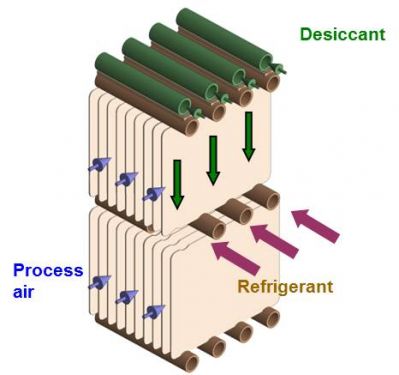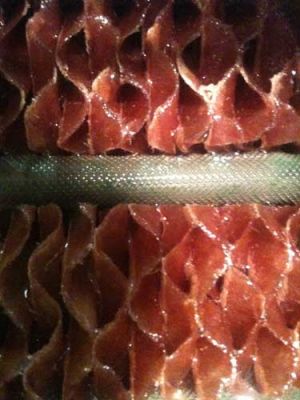 Wicking-fin technology embeds a tubular heat exchanger into a bed of porous contact media. This integration allows the temperature of a liquid that flows over the contact media to be controlled while the liquid exchanges mass with a gas that flows through the contact media.
Wicking-fin technology embeds a tubular heat exchanger into a bed of porous contact media. This integration allows the temperature of a liquid that flows over the contact media to be controlled while the liquid exchanges mass with a gas that flows through the contact media.
A simplified wicking-fin heat and mass exchanger (HMX) is shown in the neighboring figure in an application where the embedded heat exchanger is the evaporator of a vapor-compression air conditioner. As shown in this figure, low flows of liquid desiccant are delivered to the top of the HMX. The liquid desiccant (green) is first cooled as it flows over the uppermost refrigerant tubes (brown). The cool desiccant then flows from the tubes onto the first row of fins. The wicking surfaces of the fins uniformly spread the desiccant. The process air that flows horizontally between the fins is simultaneously cooled and dried as it comes in contact with the desiccant-wetted surfaces. Heat is released as the desiccant absorbs water and its temperature rises. However, the fin length is designed so that the desiccant’s temperature rises only a few degrees before it flows onto the next lower row of cooling tubes. When properly designed, the convective heat transfer of the desiccant on the fin is an effective substitute for the conductive heat transfer of the aluminum fins used in a conventional finned-tube heat exchanger.
As shown in the second figure, one possible way to implement a wicking-fin HMX is to use corrugated media as the wicking fins. This media is commonly available as either a cellulose or fiberglass substrate.
Two important operating parameters for a wicking-fin HMX are its air-side pressure drop and its operating envelope within which droplet carryover does not occur. Both these parameters are important for the more common application of corrugated media in evaporative coolers, and the manufacturers of corrugated media report these parameters. Using the Munters technical manual for its CELdek ™ corrugated media (HC/MEX/CGB-0016-04/00) as an example, a wicking-fin HMX that used 18” deep pads of CELdek ™ Type 7060-15 and operated with a face velocity of 375 fpm (1.9 m/s) would have a pressure drop of 0.26” w.c. (65 Pa).
 When flooded with water (as would be the case with an evaporative cooler), the velocity limit at which the air would strip water droplets from CELdek™ Type 7060-15 is 690 fpm (3.5 m/s) (See figures on Page 7 of the previously cited Munters technical manual). It is not now known whether droplet carryover will occur at higher or lower velocities when the corrugated media is wetted with desiccant. (Desiccant typically has a higher surface tension than water which would suppress droplet carryover; but, depending on flooding rates, its higher viscosity might lead to thicker liquid films that would encourage droplet carryover.) However, our experience has been that at a typical flooding rate and an operating face velocity of 375 fpm, which is slightly more than half the water velocity limit, droplet carryover does not occur.
When flooded with water (as would be the case with an evaporative cooler), the velocity limit at which the air would strip water droplets from CELdek™ Type 7060-15 is 690 fpm (3.5 m/s) (See figures on Page 7 of the previously cited Munters technical manual). It is not now known whether droplet carryover will occur at higher or lower velocities when the corrugated media is wetted with desiccant. (Desiccant typically has a higher surface tension than water which would suppress droplet carryover; but, depending on flooding rates, its higher viscosity might lead to thicker liquid films that would encourage droplet carryover.) However, our experience has been that at a typical flooding rate and an operating face velocity of 375 fpm, which is slightly more than half the water velocity limit, droplet carryover does not occur.
Even with a face velocity well below the limit for droplet entrainment, carryover could occur if droplets were created when the desiccant was either supplied to or collected from the wicking-fin HMX. Recognizing this potential problem sprays and drip pans should be avoided when delivering the desiccant to the top of a wicking-fin HMX. Similarly, the desiccant should flow off the bottom row of fins directly into a collection sump. Both these design requirements can be easily met in a wicking-fin HMX that has a horizontal flow of air. (Laboratory operation of a compressor-based liquid desiccant air conditioner with a wicking-fin evaporator and condenser has confirmed "zero carryover" operation. These tests are described in the section on the Compressor-Based Liquid-Desiccant Air Conditioner.)
When solutions of lithium chloride are used in a wicking-fin HMX, the embedded heat exchanger, which typically will be metallic since heat fluxes on the tubes will be high, must resist corrosion by the strong salt solution. Depending on operating temperatures, either 90/10 or 70/30 cupronickel has demonstrated good corrosion resistant to LiCl and should be considered a good candidate for this application (although any particular application of a wicking-fin HMX must prove the long-term compatibility of the desiccant and the embedded heat exchanger).
